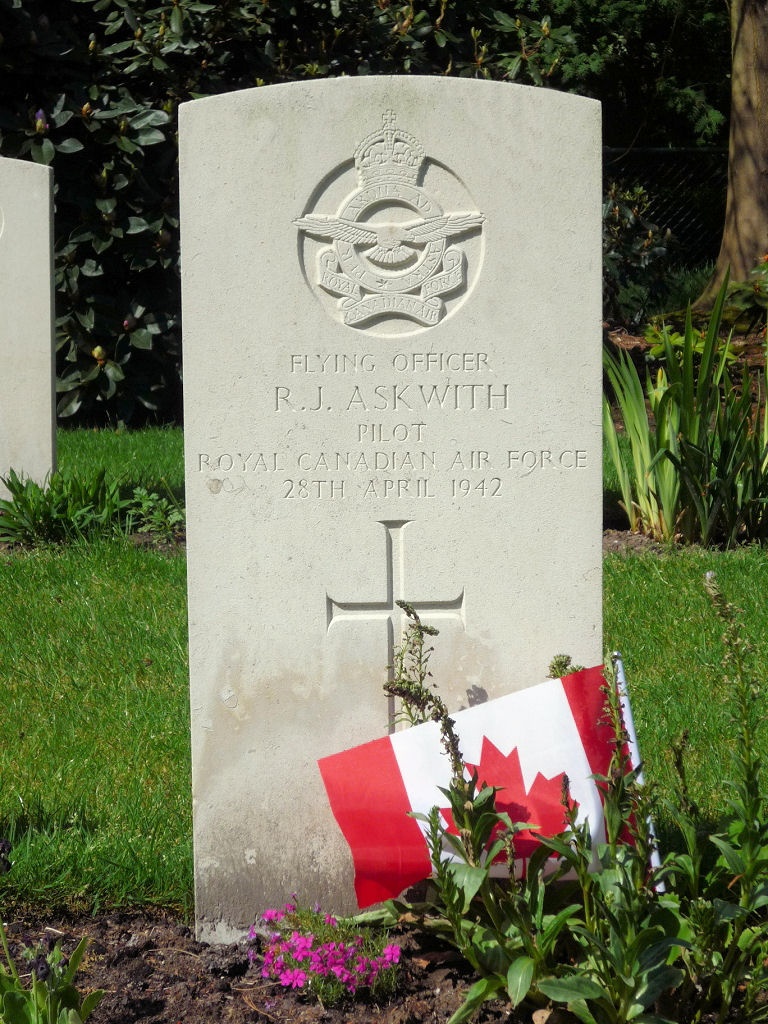Service Number: C/1611
Force: Air Force
Unit: Royal Canadian Air Force
Division: 418 Sqdn.
Flying Officer / Pilot.
Richard was the eldest of two boys born to John and Joan (nee Watts) Askwith. He attended Lisgar Collegiate from 1933 to 1937 and while there was active in sports as a member of the ski team. Other athletic pursuits included swimming, riding, tennis, football, hockey, cricket and sailing. Following junior matriculation, he was employed as a junior clerk at Canadian General Electric.
Prior to enlistment, he had been taking a flying course at the Ottawa Flying Club. He had 1 hour and 30 minutes of flying time logged as a student pilot flying a Taylor Cub.
On Apr 27, 1942, Richard was taken on strength at 418 Squadron. The squadron was formed in Nov 1941 as part of No. 11 Group, Fighter Command. It was tasked to patrol enemy airfields and dispense of the enemy as they launched operations against the Allies and generally disrupt enemy operations. It first saw action on Mar 27, 1942 in a bombing run to Belgium. The following evening, it took on the true role of "intruder" by launching patrols to various airfields such as Lille, France and Gilze-Rijen, Holland.
Richard was shot down and killed on his first operational mission over Holland, as Pilot on Boston Z2240. It was an Intruder operation to Gilze along with navigator Norman Mapes and air gunner Flight Sgt Gordon James Hardy. The objective, Gilze-Rijen, was an airbase located near Breda, Holland. It was expanded by the Germans in 1940 and built into one of the largest airfields in Europe. It was used to launch interceptors against allied aircraft who were en route to bomb Germany and it had heavy FLAK defenses.
Navigator Norman Mapes managed to bail out and survived the crash. His son, Bob Mapes, recounted the story based on what his father had told him: "It was cloudy all the way over the Channel. When they came out of the clouds over Holland it must have been a moonlight night. Dad said he could see boats on the canals from 10,000 ft. This sight seeing didn't last for long. Almost instantly dad saw a night fighter and intercommed the pilot. Next thing the plane was shuddering either from a stall or the pilot firing the guns (they would have been on both sides of Dad in the nose.) The next thing he remembers is trying to get away from the plane (it was a common experience for aircrews to be attached to the aircraft by their intercom cable) then pulling his ripcord (sit pack). Dad's theory was that whatever force threw him out of the aircraft must of also thrown the gunner out.
Unfortunately, to operate the guns his pack had to be stored on the wall. The pilot being in the center of gravity went down with the plane. Dad always thought that the fighter seemed to be waiting for them."
Service Number: C/1611
Force: Air Force
Unit: Royal Canadian Air Force
Division: 418 Sqdn.
Flying Officer / Pilot.
Richard was the eldest of two boys born to John and Joan (nee Watts) Askwith. He attended Lisgar Collegiate from 1933 to 1937 and while there was active in sports as a member of the ski team. Other athletic pursuits included swimming, riding, tennis, football, hockey, cricket and sailing. Following junior matriculation, he was employed as a junior clerk at Canadian General Electric.
Prior to enlistment, he had been taking a flying course at the Ottawa Flying Club. He had 1 hour and 30 minutes of flying time logged as a student pilot flying a Taylor Cub.
On Apr 27, 1942, Richard was taken on strength at 418 Squadron. The squadron was formed in Nov 1941 as part of No. 11 Group, Fighter Command. It was tasked to patrol enemy airfields and dispense of the enemy as they launched operations against the Allies and generally disrupt enemy operations. It first saw action on Mar 27, 1942 in a bombing run to Belgium. The following evening, it took on the true role of "intruder" by launching patrols to various airfields such as Lille, France and Gilze-Rijen, Holland.
Richard was shot down and killed on his first operational mission over Holland, as Pilot on Boston Z2240. It was an Intruder operation to Gilze along with navigator Norman Mapes and air gunner Flight Sgt Gordon James Hardy. The objective, Gilze-Rijen, was an airbase located near Breda, Holland. It was expanded by the Germans in 1940 and built into one of the largest airfields in Europe. It was used to launch interceptors against allied aircraft who were en route to bomb Germany and it had heavy FLAK defenses.
Navigator Norman Mapes managed to bail out and survived the crash. His son, Bob Mapes, recounted the story based on what his father had told him: "It was cloudy all the way over the Channel. When they came out of the clouds over Holland it must have been a moonlight night. Dad said he could see boats on the canals from 10,000 ft. This sight seeing didn't last for long. Almost instantly dad saw a night fighter and intercommed the pilot. Next thing the plane was shuddering either from a stall or the pilot firing the guns (they would have been on both sides of Dad in the nose.) The next thing he remembers is trying to get away from the plane (it was a common experience for aircrews to be attached to the aircraft by their intercom cable) then pulling his ripcord (sit pack). Dad's theory was that whatever force threw him out of the aircraft must of also thrown the gunner out.
Unfortunately, to operate the guns his pack had to be stored on the wall. The pilot being in the center of gravity went down with the plane. Dad always thought that the fighter seemed to be waiting for them."
Family Members
Sponsored by Ancestry
Advertisement
Advertisement





